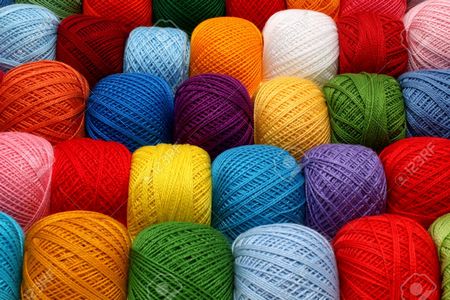Yarn Quality Requirement for Knitting and Weaving
Qualities of Yarn | Characteristics of Yarn
What is Yarn?
In textile sector, yarn is a long continuous length of interlocked fibers. Yarn is suitable for using in the production of textiles, knitting, weaving, rope making, crocheting and weaving etc. There are two sets of yarn (such as warp yarn and weft yarn) used in woven fabric manufacturing technology and one set of yarn is used knit fabric manufacturing technology.
 |
| Yarn quality for weaving and knitting |
What is Warp Yarn?
Warp yarn is that which is used in the longitudinal direction of woven fabric. It is used for preparing weavers beam.
What is Weft Yarn?
The yarn which is used for cross interlacement through the warp beam is known as weft yarn. It should be noted here that, warp yarn count is finer than weft yarn count.
Yarn must have some important qualities which will ensure the required quality of fabric. All those properties have presented in the below:
- Yarn cross section must be uniform.
- Yarn must be sufficiently and uniformly strong.
- Yarn must be uniform in cross section.
- Yarn must have less hairiness as much as possible.
- Proper and standard type and size of knots.
- Yarn must be clean and free from all kinds of dust.
- Yarn should be free from count variation.
- Knots in yarn must be in less number.
- Sizing should be done accurately in warp yarn otherwise it creates problem during passing through heald eye.
- In the weavers beam, arrangement of warp yarn must be parallel.
- Yarn should be free from loose fibre, neps and slubs as much as possible.
- Tension of warp yarn in warp beam must be uniform.
- Knots must be standard size and type so that they can pass through the heald eye, dropper and read easily.
- All warp ran should of same size in length.
Yarn Quality Requirements for Weaving:
1. Strength:
- Requirement: Yarn used in weaving, particularly warp yarns, must have high tensile strength to withstand the tension and stress during the weaving process.
- Importance: Weak yarns can lead to frequent breakages, causing downtime and reducing production efficiency.
2. Twist:
- Requirement: Proper twist is necessary to impart strength to the yarn. Warp yarns generally have a higher twist compared to weft yarns to ensure durability.
- Importance: A balanced twist prevents yarn from untwisting during the weaving process, which can lead to fabric defects.
3. Evenness:
- Requirement: Yarn should be uniform in thickness (evenness) to avoid variations in fabric texture and strength.
- Importance: Uneven yarns can cause defects like thick and thin places, leading to poor fabric quality and appearance.
4. Low Hairiness:
- Requirement: Yarn with low hairiness is preferred, especially in warp yarns, to reduce the chances of entanglement and friction during weaving.
- Importance: High hairiness can cause problems in the shedding process and lead to fabric defects.
5. Size and Count:
- Requirement: The yarn count should be appropriate for the type of fabric being woven. Finer fabrics require finer yarns, while coarser fabrics use thicker yarns.
- Importance: Matching the yarn count with the fabric design ensures the desired fabric weight and texture.
6. Elongation:
- Requirement: Yarn should have controlled elongation properties to ensure it can stretch slightly without breaking during weaving.
- Importance: Proper elongation allows the yarn to absorb some of the tension during weaving, reducing the risk of breakage.
Yarn Quality Requirements for Knitting:
1. Flexibility and Elasticity:
- Requirement: Knitting yarns need to be flexible and elastic to form loops without breaking.
- Importance: Elasticity helps maintain the structure and shape of the knitted fabric, preventing distortion during and after knitting.
2. Evenness:
- Requirement: Like weaving, knitting yarns should be even in thickness to produce uniform stitches and avoid fabric defects.
- Importance: Uneven yarn can result in inconsistent loop formation, leading to an irregular fabric surface.
3. Softness:
- Requirement: Softness is important for knitting yarns, especially for garments, to provide comfort and a good hand feel.
- Importance: Soft yarns improve the wearability and aesthetic appeal of the final knitted product.
4. Low Twist:
- Requirement: Knitting yarns generally have a lower twist compared to weaving yarns to ensure they remain flexible and can easily form loops.
- Importance: A lower twist prevents the yarn from becoming too stiff, which would make knitting difficult and produce a rough fabric.
5. Strength:
- Requirement: While strength is important, knitting yarns don’t need to be as strong as weaving yarns, as the knitting process exerts less tension.
- Importance: Adequate strength is still necessary to prevent yarn breakage during knitting, especially in high-speed machines.
6. Hairiness:
- Requirement: Lower hairiness is preferred to avoid issues like snagging and pilling in the final fabric.
- Importance: Excessive hairiness can lead to a rough texture and lower the overall quality of the knitted fabric.
Factors Affecting Yarn Quality for Both Processes:
- Fiber Content: The choice of fiber (cotton, wool, polyester, etc.) influences the properties of the yarn, such as strength, softness, and elasticity. The fiber type should be suitable for the end-use of the fabric.
- Moisture Content: Proper moisture content in yarn helps maintain its flexibility and reduces static issues during processing.
- Cleanliness: Yarns should be free from impurities and contaminants, as these can cause defects in the fabric and damage machinery.